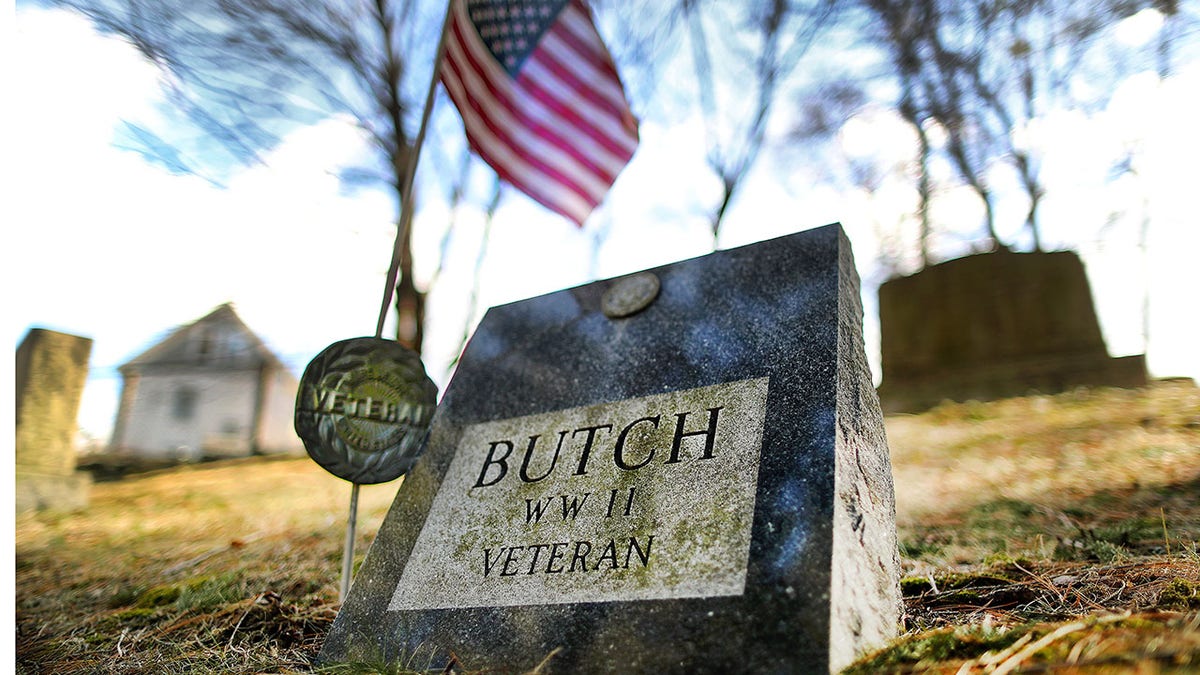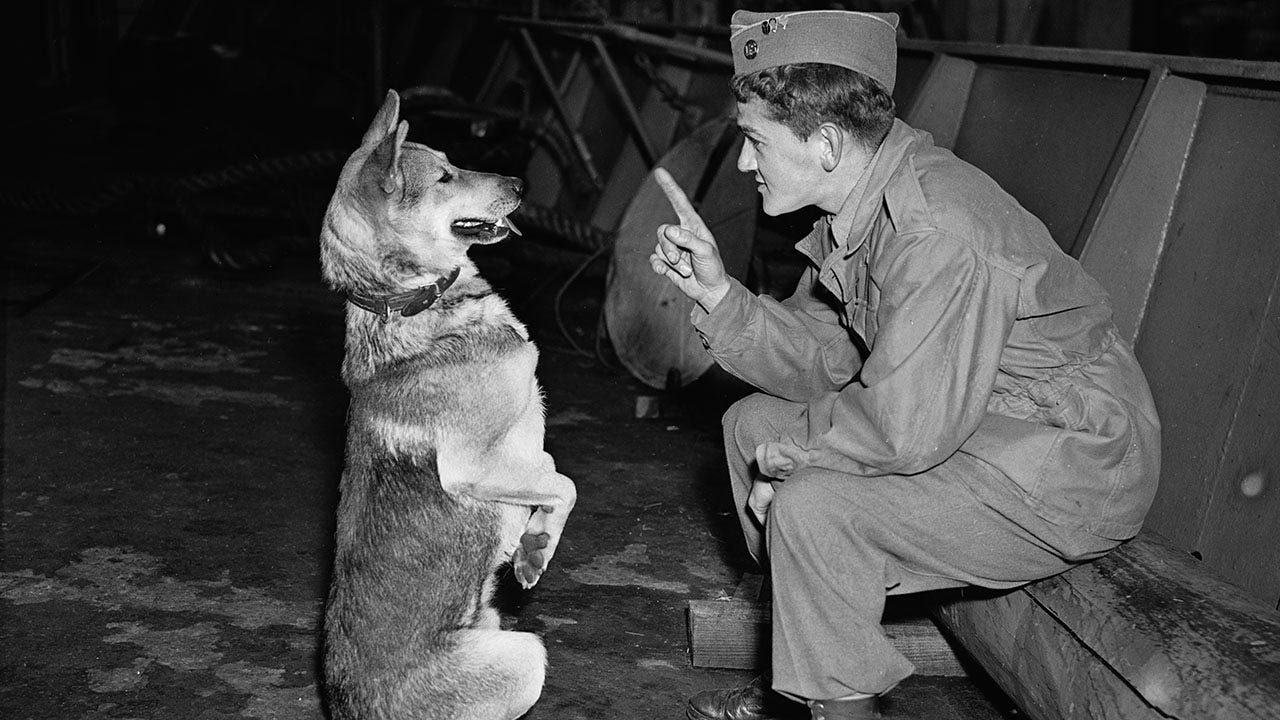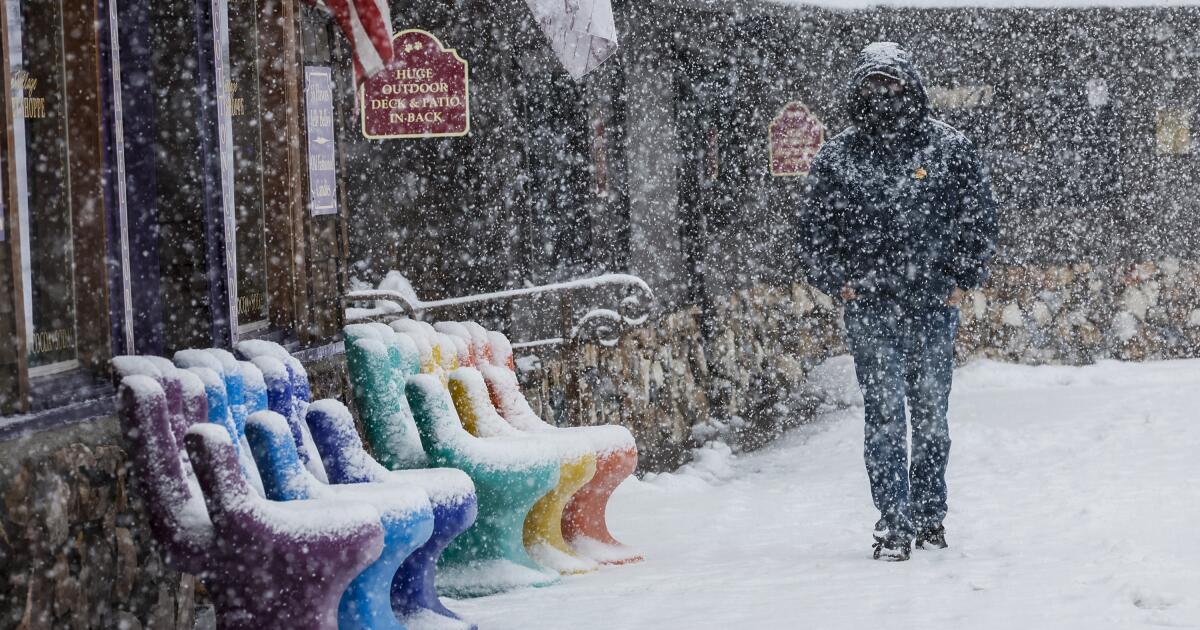The US Army K-9 Corps, which trained more than 10,000 dogs to serve in various branches of the US military in World War II, began barking orders at its four-legged infantrymen on this day of history, March 13, 1942.
“Dogs have been associated with the United States military since its inception, but their role has primarily been as a pet or some other unofficial capacity,” Dr. Arthur W. Bergeron Jr. of the Institute of History wrote in 2016. US Army Military.
He added: “It wasn't until World War II that the Army made the connection official.”
ON THIS DAY IN HISTORY, MARCH 12, 1933, FDR GIVES HIS FIRST 'FIREPLACE CHAT' RADIO ADDRESS
The American Kennel Club organized a civilian group called Dogs for Defense in January 1942, in the frantic weeks after the attack on Pearl Harbor awakened the righteous power of the American people (and American puppies).
Lieutenant Colonel Clifford C. Smith of the Army Quartermaster Corps became aware of the American Kennel Club's effort and raised the idea of the K-9 Corps at the flagpole with Maj. Gen. Edmund B. Gregory.
(Original title) 11/3/1945-RETURN OF THE WAR DOGS: The first members of the platoons of infantry scout dogs that arrive from abroad regain their land legs by training with their masters, as this one does here. He returned with over 90 dogs that served in the 5th Army in Italy. (Getty Images)
The unit gained approval from Under Secretary of War Robert P. Patterson and began training dogs for the U.S. Navy, Marine Corps, and Coast Guard, as well as the Army.
“The K-9 Corps initially accepted more than 30 dog breeds, but the list was soon narrowed to seven: German Shepherds, Belgian Shepherds, Doberman Pinschers, Collies, Siberian Huskies, Malumutes and Huskies,” reports The US Army Airborne. &Special. Fayetteville Operations Museum, North Carolina.
“Dogs have been associated with the United States military since its inception.” — US Army Institute of Military History
“K-9 Corps members were trained for a total of 8 to 12 weeks. After basic obedience training, they were sent through one of four specialized programs to prepare them for work as sentry dogs, scout dogs or patrol dogs, messenger dogs or mine detection dogs.”
Active duty combat dogs served as scouts and sentries, patrolling the movements of enemy forces or warning of possible surprise attacks.

A grave for a World War II military dog at the Hillside Acre Animal Cemetery in Methuen, Massachusetts. The cemetery is more than 100 years old and is one of the oldest in the country. (John Tlumacki/The Boston Globe via Getty Images)
Chips, a combat canine who served with the 3rd Infantry Division in Sicily in 1943, became a US Army legend when the fearless dog attacked a machine gun emplacement and, despite suffering a gunshot wound, forced the garrison to surrender.
US SOLDIERS WORK TO BRING PARALYZED PUPPY TO SAFE AFTER MIDDLE EAST RESCUE: 'SHEMBLING IN PAIN'
“Among the troops that attacked the beach was the Military Police's 3rd Platoon, 30th Infantry Regiment, which contained Private John R. Rowell of Arkansas and his sentry dog, Chips,” Defense Media Network states.
“I saw an Italian soldier come out with Chips in his neck… Three others followed him, with their hands above their heads.” — Pvt. Juan Rowell
“When dawn broke, the platoon was making its way inland when a machine gun nest hidden in what appeared to be a nearby peasant hut opened fire. Rowell and the rest of the platoon immediately fell to the ground. But Chips broke free of his guide and , growling, ran towards the cabin… The soldiers heard someone inside the cabin firing a gun.”
Said Pvt. Rowell of the incident: “Then there was an awful noise and the shooting stopped.”

Chips, a war dog who was commended for his bravery in the Sicily campaign, is shown receiving a donut from a soldier. (Getty Images)
“I saw an Italian soldier come out with Chips in his throat. I called out to him before he could kill the man. Three others followed him, with their hands above their heads.”
The wounded Chips received the Distinguished Service Cross, the Silver Star, and the Purple Heart, although the awards were later rescinded due to Army policy, which opposed such praise for animals.
MEET THE AMERICAN WHO HONORS THE MEMORY OF 200,000 FALLEN WAR HEROES
The dogs also served heroically in the Pacific Theater, most notably in the Battle of Guam in 1944.
“Kurt, a Doberman Pinscher, was a scout dog during World War II and is estimated to have saved the lives of 250 Marines in Guam,” writes the website of the National Service Animal Memorial, which has been proposed as a way to honor the K- 9 shillings.
“He was mortally wounded when he went in front of the troops to warn them of the dangers that lay ahead.”

Petty Officer 2nd Class Blake Soller, a military working dog (MWD) handler, pets Rico's boss at the war dog cemetery located on Naval Base Guam on October 27, 2006. (Public domain)
An incredible 25 members of the K-9 Corps died on Guam, making it perhaps the deadliest dogfight in American history.
The National War Dog Cemetery was dedicated at Naval Base Guam in 1994 to honor the sacrifices of brave American troops.
Dogs have served in the United States Armed Forces since the nation's earliest days.
The American Battlefield Trust traces canine service to the country to the American Revolution and to the “father of the American foxhound”: George Washington himself.
The foxhounds bred by General Washington at Mount Vernon were “a more intelligent and faster variant of their French and British counterparts,” the trust boasts.
CLICK HERE TO SUBSCRIBE TO OUR LIFESTYLE NEWSLETTER
“The breed was officially recognized by the American Kennel Club in 1886. The American Foxhound is now the official dog of Virginia's home state of Washington.”
Dogs emerged as a formidable fighting force in Europe during World War I, when more than 1 million dogs served on all sides of the conflict.
“As the first animal movie star, Rin Tin Tin made the little-known breed of German Shepherd nationally famous.” — US Army Airborne Museum
“The most famous dog to emerge from the war was Rin Tin Tin, an abandoned German war dog found in France in 1918 and brought to the United States, where he made his film debut in the 1922 silent film 'The Man from Hell's River. '.'” writes the US Army Airborne and Special Operations Museum.
“As the first animal movie star, Rin Tin Tin made the little-known breed of German Shepherd nationally famous.”
Rin Tin Tin reportedly won the first Oscar for Best Actor in 1929, only for the award to be rescinded and given instead to German actor Emil Jennings.

Poster “Regiment Dog” starring Rin Tin Tin, 1927. (LMPC via Getty Images)
“It has been seen as one of the darkest scandals in the Academy's history: the story of a beloved Hollywood star who was stripped of his rightful Oscar for best actor by a cowardly Hollywood establishment,” the Guardian reported. London in 2012.
The story cited Rin Tin Tin's biographer, Susan Orlean, as one of the sources of the injustice rumor.
The US military says it used 1,500 dogs during the Korean War, 4,000 in the Vietnam War and hundreds more in Iraq and Afghanistan.
CLICK HERE TO GET THE FOX NEWS APP
War dogs provide services to troops in ways that can't always be summarized in a combat report or pop culture honor, writes the American Battlefield Trust.
“In times of war, dogs would help hunt and act as messengers, but they also provided a much-needed morale boost to homesick wounded and disillusioned soldiers.”
For more lifestyle articles, visit www.foxnews.com/lifestyle.












